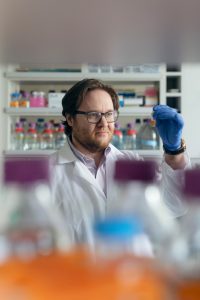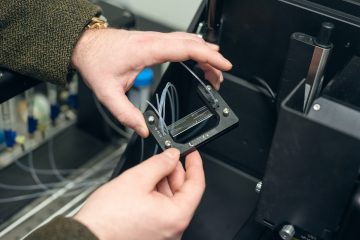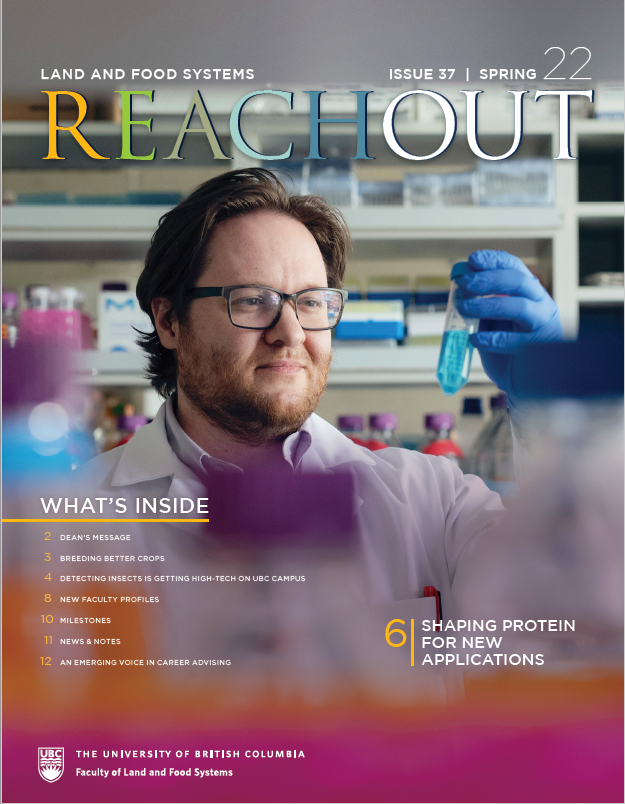Shaping Protein for New Applications

Transforming protein has been in the spotlight in the last decade as plant-based protein products grow in popularity. Current commercial processes rely on extruded plant protein to make meat substitutes, but Assistant Professor Derek Dee’s research focuses on changing protein on a nanomolecular level.
Funded by a New Frontiers Grant and still in its early stages, Dee’s research focuses on the process of manipulating plant protein for application in food production, as a meat substitute, and more.
“We’re working with proteins on a molecular level,” Dee explains. “That’s a nanometre, or a billionth of a metre. This type of protein research spans biophysics and health science, and is novel in food science.”
Dee’s fascination with the biophysics of proteins began over a decade ago, studying prions in the University of Alberta. Prions are proteins that exist in everyone’s bodies, and every protein has a structure made from folds. However, through a process called misfolding, prions can turn from a benign molecule to a harmful pathogen.
Dee wanted to understand exactly what caused the misfolding, so he could learn to change a protein’s shape to benefit different aspects of human life instead.
At UBC, Dee’s research focuses on legume proteins. Similar to prions, his lab unfolds and refolds proteins using a special tool called optical tweezers. The tweezers use lasers to trap a single molecule, allowing Dee’s team to observe proteins under different conditions. Dee’s lab creates new protein nanofibres by varying temperatures, salt concentrations, pH levels, and other factors.
Dee emphasizes the importance of state-of-the-art equipment to his research.
“Optical tweezers have only been used in basic science, like chemistry or physics,” Dee explains. “Until 2016, if you wanted a good instrument, you had to build it yourself! Now there’s a company in the Netherlands who sells them. That’s what’s making this research possible.”

Access to revolutionary equipment is only fitting for the type of research at Dee’s lab. When starting in 2019, there were less than 20 papers in the world on plant protein nanofibrils.
Compared to the current meat substitute extrusion methods, Dee explains protein folding as a bottom-up approach. With extrusion, all the molecules are ground down, mixed up, then pressed together. This unfolds all the proteins and leaves them to clump together in random ways, very unlike the fibres that actually make up meat.
Meat is made from muscle fibres, organized from the molecular level up. By folding protein, Dee’s team can create protein strands that self-assemble into functional amyloid fibres under specific and controlled conditions. Then eventually, the functional amyloid fibres can be layered into an approximation of meat.
Meat substitutes are just one potential application. The functional amyloid fibres can be used to make emulsions, gels, and films to use for controlled release and delivery. Additionally, amyloid fibres are how biofilm attaches to surfaces, so learning to manipulate the fibres can allow food production plants to better manage biofilm and bacteria spread.
On the distant horizon, Dee mentions bio-electronics and cell-structures as possible future collaborations. When starting his lab in 2019, Dee was the only one in Canada working with plant protein nanofibers. Now, there is a group in Alberta and another starting in Ontario.
“This is still in the early stages and everything in between protein to fibre is a big question mark,” said Dee. “We are working on how the fibrils are made and how to control them. Why do different plant fibrils look different? What causes them to react the way they do?”
However, Dee is optimistic about the growth of his field, with more interest, funding, and growing demand around plant-based protein.
Tagged with: 2022, Faculty, Food Science
